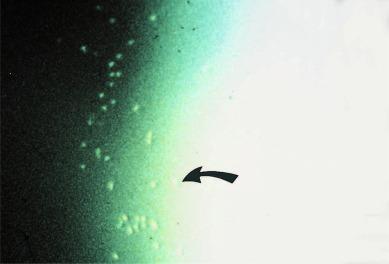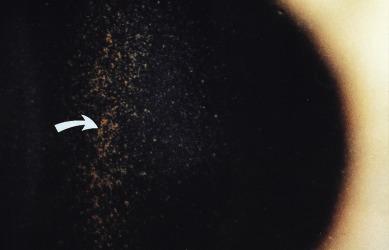Physical Address
304 North Cardinal St.
Dorchester Center, MA 02124
Eye care practitioners from time to time will observe deposits, such as keratic precipitates, on the endothelial surface. These may be benign or may be associated with a broad range of uveal responses. In 1979, McMonnies and Zantos described the appearance of endothelial deposits of uncertain origin in patients who were intolerant to contact lens wear ( Fig. 29.1 ). They described this condition as ‘endothelial bedewing’. This condition was further discussed soon thereafter by Zantos and Holden ; however, since then, this topic has received little attention in the literature.
As will be discussed in this chapter, it is not at all clear that endothelial bedewing is induced by contact lens wear; however, there appears to be an association between lens wear and endothelial bedewing. This association is worth considering because specific management strategies need to be employed to solve the problem.
Deposits or pigment spots on the endothelium (or on the anterior lens capsule) are commonly observed during routine slit lamp examination of all patients. These are often benign and do not affect vision, except in rare cases.
Hickson and Papas conducted an extensive biomicroscopic examination on 70 normal, asymptomatic, consecutively presenting, non–contact lens wearers and found that 20% of the sample displayed endothelial bedewing. The authors concluded that endothelial bedewing could occur idiopathically in non-lens-wearing eyes.
McMonnies and Zantos reported seeing 25 patients with endothelial bedewing associated with contact lens intolerance over a 9-month period, suggesting that this condition is not uncommon. However, it is important to recognise that these observations were made some time ago, when the contact lens market was dominated by soft contact lenses, which were replaced infrequently, made of materials of low oxygen transmissibility (primarily hydroxyethyl methacrylate), and maintained using relatively unsophisticated lens care systems. At that time, contact lenses in general were associated with a higher prevalence of adverse reactions – relating to spoiled lenses and mildly toxic solution preservatives – compared with the present-day situation.
Surveys conducted between 1992 and 2018 of contact lens complications among patients presenting to large clinics or hospital eye departments – carried out in China, India, Japan, Nepal, Singapore, the USA and the UK – have failed to report any form of endothelial dysfunction. It is, therefore, not possible to deduce the prevalence of contact lens–associated endothelial bedewing in modern-day contact lens practice.
Contact lens–associated endothelial bedewing is characterised by the appearance of small inclusions on the endothelial surface, which are most easily seen in the region of the inferior central cornea near to or immediately below the inferior pupil margin. The area of bedewing can vary in shape. For example, endothelial bedewing may appear as an oval cluster of inclusions or a less discrete dispersed formation. The condition is usually bilateral.
The preferred slit lamp observation technique is marginal retro-illumination, where the attention of the observer is directed to the region of the cornea in front of the border between the brightly illuminated iris and the dark pupil. With this technique, the particles or inclusions are seen as small discrete circular optically translucent entities. Most cells appear to display an optical phenomenon known as ‘reversed illumination’ whereby the distribution of light within the cell is the opposite of the background distribution of light ( Fig. 29.2 ). However, in some cases of endothelial bedewing, the inclusions can also display unreversed illumination. The optical basis for these characteristic forms of illumination has been discussed in Chapter 19 .

When viewed in direct illumination, endothelial bedewing can appear as fine, white precipitates or as an orange/brown dusting of cells. Coloured particles are likely to be cellular debris (see ‘Pathology’ ), and their actual colour can give a clue to the length of time they have been present. Newly deposited cells are often whitish in colour, but these become pigmented over time.
Figure 29.3 is a slit lamp photograph of the right eye of a 35-year-old male referred for assessment of suitability for contact lenses to correct myopia. An extensive ‘dusting’ of brown pigment can be observed in a spindle shape characteristic of pigment dispersion syndrome (the so-called Krukenberg spindle).

There appears to be no fixed pattern of associated signs. Among their detailed case reports of three patients, McMonnies and Zantos noted the following signs (in addition to bedewing): conjunctival redness, epithelial erosion, epithelial oedema and reduced corneal transparency. There were no cases of flare in the anterior chamber.
The main associated feature of endothelial bedewing is either total or partial intolerance to lens wear. Some patients may present after having recently abandoned lens wear. Patients may also complain of ‘fogging’ of vision or stinging. It should be noted, however, that the association between bedewing and lens intolerance is not obligatory; McMonnies and Zantos observed two cases of endothelial bedewing in successful lens wearers.
Mackie described a condition which he named ‘total endothelial bedewing’. According to Mackie, this acute phenomenon occurs in hydrogel lens wearers. Patients usually present complaining of blurred vision. The condition resolves rapidly (within 2 days of lens removal) and does not recur. It is unclear whether Mackie was observing the same phenomenon as that reported by McMonnies and Zantos.
Brooks et al. examined the posterior surface of the endothelium by using the ‘relief mode’ of an endothelial specular microscope and observed numerous deposits, including red blood cells, white blood cells, keratic precipitates, pigment granules and pseudo-exfoliative keratic precipitates. Using corneal confocal microscopy, Bastion and Mohamad observed small white dots throughout the corneas of 56 soft contact lens wearers. In one patient, these were observed at the level of the endothelium.
Become a Clinical Tree membership for Full access and enjoy Unlimited articles
If you are a member. Log in here